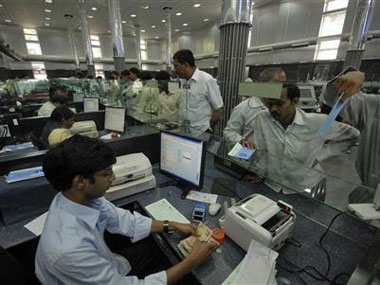Investors in bank shares were in for a rude shock as none of there no proposal in the Budget that could lend cheer to them.
While lack of clarity on recapitalisation marred the prospects for public sector banks, for their private sector peers there was almost nothing. Interestingly, there were a slew of proposals related to the banking sector in the Budget.
The finance minister has proposed to allow banks raise long-term funds for lending to the infrastructure sector with minimum regulatory preemption such as CRR, SLR and Priority Sector Lending (PSL).
CRR or cash reserve ratio is an RBI stipulation that mandates banks to keep 4 percent of their net demand and time liabilities (deposits) with the RBI, for which they earn no interest.
[caption id=“attachment_90235” align=“alignleft” width=“380”]
 Can banks afford to pay the tax man? Reuters image[/caption]
Can banks afford to pay the tax man? Reuters image[/caption]
SLR, or statutory liquidity ratio, is the proportion of deposits banks need to hold in government securities. This currently stands at 22.5 percent.
Priority sector lending norms stipulate that 40 percent of banks’ lending has to be to sectors that are categorised as priority sectors, which include agriculture, micro and small enterprises, education, housing, export credit etc.
Banks have termed these norms restrictive. The proposal frees banks from these norms provided they are lending the funds to infrastructure sector.
But that is just a small positive. For one, not may private sector banks finance infrastructure projects. For public sector banks, there are other bigger worries. First and foremost, there is no clear road map about recapitalisation.
Reeling under a huge NPA burden, state-owned banks were dependent on the government for capital infusion.
“To be in line with Basel-III norms there is a requirement to infuse Rs 2,40,000 crore as equity by 2018 in our banks,” the finance minister said in the speech.
“While preserving the public ownership, the capital of these banks will be raised by increasing the shareholding of the people in a phased manner through the sale of shares largely through retail to common citizens of this country,” he added.
However, the government will continue to hold majority stake, the citizens of India will also get direct shareholding in these banks, which currently they hold indirectly.
The government is also exploring the proposal to give greater autonomy to the banks while making them accountable, he said. This is seen negative for banks as the responsibility to raise funds rests on banks, while political intervention will continue.
Rating agency Crisil is of the view that additional clarity on quantum of capital for public sector banks was desirable.
The minister also said the government will consider consolidation of banks. As R Jagannathan noted this means nothing until he actively promotes it.
There has been a proposal to set up six more debt recovery tribunals “to improve banks’ bad loans situation”. But as Sucheta Dalal, amanging editor, Moneylife tweeted, “Debt recovery broken down. How will 6 more debt recovery tribunals help? Need to make bank chairmen accountable!”
One truly positive proposal which will have a positive cascading effect on banks is the higher tax of 20 percent and lengthier holding time for debt funds. This will render bank deposits more attractive. As a safe avenue, investors are likely to flock to banks to park their funds.
)